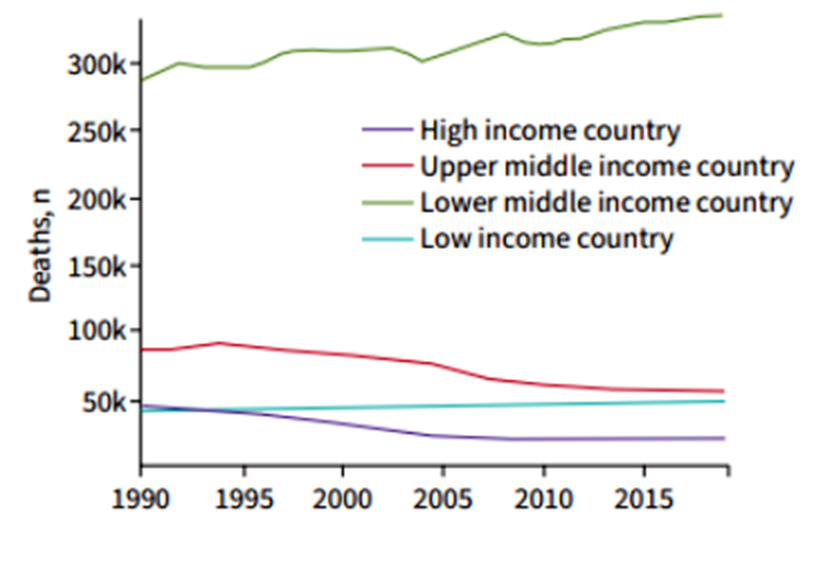Author: Hafeez Hamza

In 2019, Asthma affected 262 million people globally and caused 455,000 deaths, asthma has emerged as one of the most pressing yet overlooked public health challenges in the world today 6. While often perceived as a manageable condition in high-income countries, asthma in low- and middle-income countries (LMICs), particularly across the African continent, presents a far more dire picture. The rising prevalence, staggering underdiagnosis, and preventable mortality demands immediate attention from global health leaders and policymakers 1.
In 2019, asthma affected an estimated 262 million people globally
The Growing Burden: Prevalence and Mortality Trends
Approximately 90% of the asthma burden of disease is borne by people living in low and middle income countries (LMICs) 2. The burden of asthma in Africa has been growing at an alarming rate. Between 1990 and 2010, the number of African children with asthma surged from 34 million to over 50 million, an increase largely attributed to rapid urbanisation and worsening air pollution 5. This growth has not been evenly distributed across the continent. South Africa reports the highest prevalence at 23.8% of adolescents experiencing asthma symptoms, while Malawi shows the lowest at just 4.2% 3 .
Perhaps most concerning is the finding that 80% of African adolescents with asthma symptoms remain undiagnosed, leaving them without access to potentially life-saving treatment 3. The mortality rates are particularly shocking when compared to high-income nations. In Uganda, the asthma mortality rate stands at 90 times that of the United Kingdom 4. These deaths are especially tragic because they are largely preventable with proper access to basic asthma medications and care.
90% of the Asthma burden of disease is borne by people
living in LMICs

Figure 1 – Between 1990 and 2019, the number of asthma-related deaths in lower-middle-income countries significantly surpassed those in other income categories. Source – Kevin Mortimer et al.,
Treatment Gaps: When Relief Remains Out of Reach
Treatment gaps compound these diagnostic failures. Inhaled corticosteroids (ICS), the cornerstone of effective asthma management globally, remain largely inaccessible across Africa due to both availability and affordability issues 1. This has led to an overreliance on short-acting β-agonists (SABAs), which provide temporary symptom relief but fail to address the underlying airway inflammation. Shockingly, 32% of African adolescents with diagnosed asthma and severe symptoms use no inhalers at all, while 77.7% of those using reliever medications still have poorly controlled asthma 3. In some cases, healthcare providers resort to prescribing outdated and potentially dangerous alternatives like oral theophylline due to the lack of better options 4.
80% of African adolescents with asthma symptoms remain undiagnosed
Environmental Triggers: The Air They Breathe

Environmental factors create additional layers of complexity in managing Africa’s asthma burden. Air pollution exposure is nearly ubiquitous, with studies showing 47.4% of African adolescents regularly exposed to bushfire smoke, 55.3% to mosquito coils, and 25.8% to indoor biomass cooking fumes 3. These environmental triggers interact with poverty to create a vicious cycle where asthma exacerbations lead to lost school and work days, which in turn deepens economic hardship and limits access to care 3. The cost of asthma medications often represents an insurmountable barrier, with some families needing to spend an entire week’s wages just to purchase a single inhaler 1.
Pathways to Progress: Diagnosis and Treatment Innovations

Despite these formidable challenges, evidence-based solutions exist that could dramatically improve asthma outcomes across Africa. School-based screening programs using mobile clinics could help identify undiagnosed cases early, while integrating basic diagnostic tools like spirometry into primary care settings would improve accuracy 3. Treatment protocols need urgent updating, with single-inhaler ICS-formoterol therapy showing particular promise by reducing exacerbations by 60% compared to SABA-only approaches 1. Low-cost innovations, such as homemade spacers crafted from plastic bottles, have proven effective in resource-limited settings and could be scaled up immediately 3.
Conclusion: A Call for Equitable Asthma Care
The asthma crisis in Africa represents more than just a medical challenge, it is a profound failure of global health equity. With prevalence rising, mortality rates remaining unacceptably high, and systemic barriers persisting, the need for action has never been more urgent. The solutions are known and achievable, but they require political will, international cooperation, and sustained investment. Every preventable asthma death in Africa stands as a stark reminder that we have the tools to save lives, we simply need the determination to deploy them equitably. The time to act is now, because no child should die for lack of an inhaler.
References
- Mortimer, K., Reddel, H. K., Pitrez, P. M., & Bateman, E. D. (2022). Asthma management in low and middle income countries: case for change. The European respiratory journal, 60(3), 2103179. https://doi.org/10.1183/13993003.03179-2021
- Meghji J, Mortimer K, Agusti A, et al. Improving lung health in low-income and middle-income countries: from challenges to solutions. Lancet 2021; 397: 928–940. doi: 10.1016/S0140-6736(21)00458-X
- Oyenuga, Victoria O et al. “Asthma symptoms, severity, and control with and without a clinical diagnosis of asthma in early adolescence in sub-Saharan Africa: a multi-country, school-based, cross-sectional study.” The Lancet. Child & adolescent health vol. 8,12 (2024): 859-871. doi:10.1016/S2352-4642(24)00232-3
- Faniyi, A.A., Okesanya, O.J., Nukpezah, R.N. et al. Addressing the asthma crisis in Africa: challenges, strategies, and recommendations for improved management. Egypt J Intern Med 36, 76 (2024). https://doi.org/10.1186/s43162-024-00340-6.
- Refiloe M, Kevin M, Rebecca N, Maia L, Hellen M, Graham D, et al. Asthma care in sub-Saharan Africa: Mind the gap! J Pan Afr Thorac Soc 2022;3:59-62.
- Global burden of 369 diseases and injuries in 204 countries and territories, 1990–2019: a systematic analysis for the Global Burden of Disease Study 2019. Vos, Theo et al. The Lancet, Volume 396, Issue 10258, 1204 – 1222


